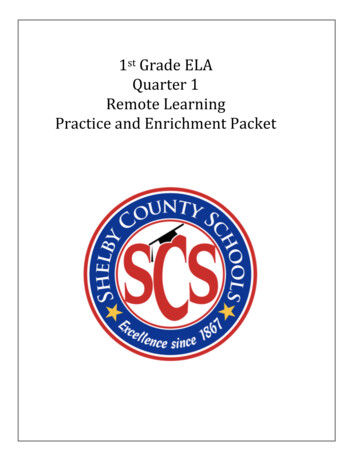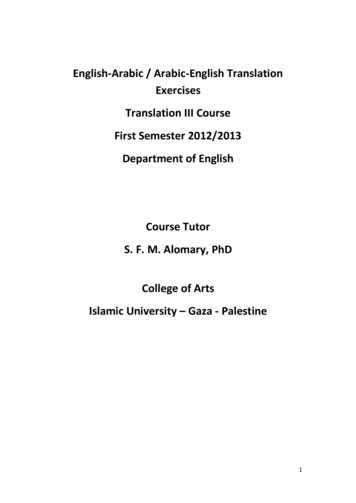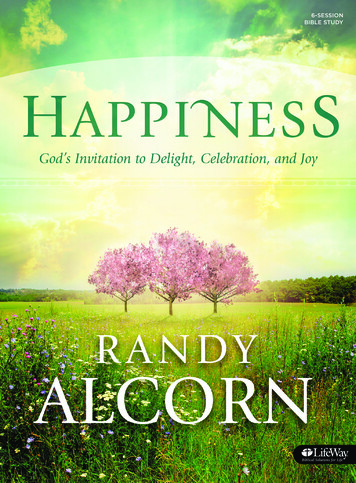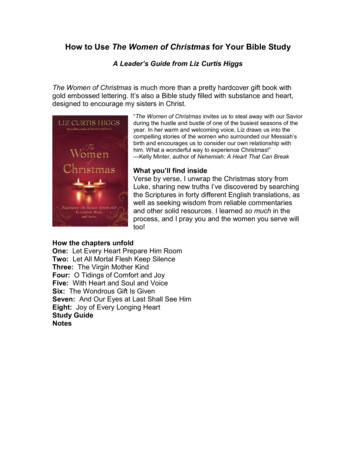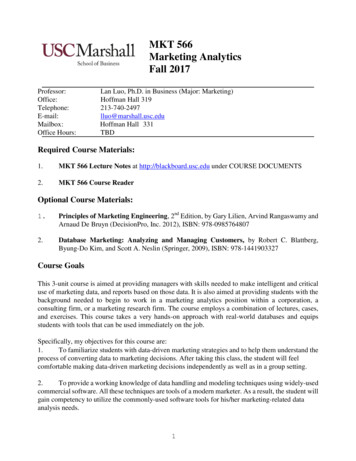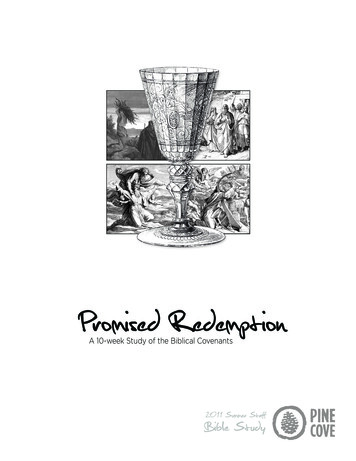
Transcription
A 10-week Study of the Biblical Covenants
mmer Staff::Dear Sumame that wee can tell a story about something amazing thhat happeneed to us whileIt’s a shaplaying a game of ultimate Frisbee, but whhen we sharre the story of the Gosppel we stummble overour wordds, stare at the ground,, and muddyy it over witth clichés. TThe story of redemptionn is onethat needs to be toldd! It needs to be told completely, accurately, and with coonviction.y throughouut the course of studyinng the Bibliccal covenantts this summmer you willl beHopefullybetter abble to formuulate the parrts of that storysso thatt you can teell it not justt to your campers,but to yoour families,, classmatess and commmunities.ber, don’t bee the end usser of this sttudy. Re-innvest what yyou have leaarned into tthe livesRemembof the peeople you ministermto baack at homee and schoool. It will noot only be a blessing to thosewhom yoou choose too spend time with, it will further ceement whatt you have leearned thissummer.n only do youyhave thhe notes to tthis study, yyou also havve access too theAnd don’t forget – notcordings as well! If youu’re not alreeady subscrribed to the podcast, yoou can find tthe feedaudio recand download the episodes by visitingvthe summer staaff blog at wwww.pinecovve.com/stafffblog.ou can find thetaudio file for each weekwas welll as the linkk to the podcast feed onnThere yoiTunes.fto nextnsummeer when we’ll get to do this all overr again! In the meantimme,I’ll look forwarddon’t forrget about thhe opportunnity you havve at the Forrge. If you are interestted in applyying,please give me a call – I’d love to speak with you abo ut it.nd peace be with you,Grace anMatt “DyynoLight” LaantzForge Directorce903.579.3674 - offic@pinecove.coommlantz@www.pinnecoveforge.com
Promised RedemptionInstructions for Teachers & BibliographyHow To Use This Study: Step 1: Familiarize yourself with the Text. These notes assume that you are already familiarwith the passages being studied, so don’t expect to be able to sit down with the note pack andeasily walk through the study without a little prep work on your part.Step 2: Decide which parts of the passage are the ones you want to focus on. These lessonsare NOT designed to teach the lesson for you. You have more things to teach here than youcould/should possibly teach in a 30-45 minute lesson. You must decide which parts of the Textand notes are most pertinent to the group you’re teaching.Step 3: Don’t bore or insult your study group by reading the study to them point by point.Instead, have a general outline of thoughts and your own personal illustrations that make thestudy come alive. Think of these notes like the bone structure and skin. It is your job as theteacher to make the study come to life. Feel free to change the study as you like.Step 4: Look for opportunities for application. The thrust of this note pack is focused onhelping you, the teacher, prepare well for your study. You will need to encourage applicationwith your small group based on who they are and what your relationship is with them.Whatever the case, don’t skip this step – otherwise this study will just be an exercise ininformation transfer.Step 5: Listen to the podcast. AFTER you have done your own personal prep work, you mightwant to listen to how I taught it so you can get an idea of how much to teach, illustrations, etc.Copy and paste this feed into iTunes to download it:Step 6: Copy these notes and distribute them each week to your small group. No need to givethem lessons in advance – once per week will be good. Encourage them to use the notes as aguide for the rest of the week for their quiet times so they can dive deeper into the lesson ifthey would like to.Remember: These notes are mine. You have to make them yours. Until the Text becomessomething you are passionate about and familiar with you will have a lot to say and nothing toteach. Change this up as much as you want – add more quotes/references. Make it your own.The most inspiring and effective teachers are those who own what they teach.Tough Questions:It’s hard to replace the value of a good question that will keep your students learning even afterthey leave your study. Each week there will be a question or two at the end of the study that isdesigned to make your students (and you!) think hard about the subject just discussed.Sometimes the questions aren’t even answerable – but that’s not the point. The point is that theyare engaging the Word on their own (and they’re motivated to do so!). Don’t worry about youranswers – there is more to be learned in the investigation of the question most of the time than indetermining what the right answer is.Sample Schedule for Summertime:6:50am – Arrive before they do & make sure there is coffee!7:00am – Start your Bible study promptly on time. No need to waste time asking “how was yourweek” or “how are you feeling.” They will get that in their small group time. Get straight tothe meat – you’ll need every minute!7:40am – If you want to have time for Q&A at the end, plan on ending the study a little early.Then you can have some dialogue about the text or discuss the tough question from theweek before.7:45am – Dismiss the study promptly. Do not go over on time as it obstructs the flow of camp.1
Bibliography:There are not many single volumes out there about the covenants themselves. Most of myresearch has come from a few sources and then random commentaries. As I compiled my notesand thoughts, these were the resources that I found to be the most helpful. If you would like tostudy further, I would recommend these resources to you first as good entry points. So, to thedegree you find this study helpful, you need to know it really comes from the wisdom of thesebrothers in Christ. I’m just the young guy standing on their shoulders.Primary Sources: Constable, Tom. Expository Notes on the Bible. 2008 edition.o Dr. Constable, a seminary professor of mine, makes his expository notes on theentire Bible available online for free! You can download them at www.soniclight.com. Blaising, Craig A., Bock, Darrell L. Progressive Dispensationalism. Grand Rapids: BakerBooks, 1993.o I relied heavily on this volume not because I am an advocate of dispensationalismbut because of its excellent overview and summary of each of the Biblical covenants.I have tried to use quotes that do not force a dispensational or covenant theologyperspective. Nevertheless, when studying the covenants it is hard to avoid resourcesthat focus on these theological frameworks. Ross, Alan. The Divine Plan from Paradise to Paradise. The Biblical Studies Foundation,2005. (obtained online at www.bible.org)o Dr. Ross’ perspective on the Hebrew Bible is invaluable. This short overview of thestory of Redemption was most helpful to me in organizing the outline of the studyand how I would present the material. Walvoord, J. F., Zuck, R. B. The Bible knowledge commentary. Wheaton, IL: Victor Books.o This is a must-have resource for any lay-leader’s library. It is a concise commentaryon the entire Bible and offers a thorough, conservative, evangelical interpretation ofthe Text. Most helpful in understanding the big picture of a book.Secondary Resources: Precept Austino www.preceptaustin.org is a fantastic online resource that has great exegetical bulletpoints verse by verse through every book of the Bible. Additionally, it is a greatresource for quotations from well-known Christian leaders, pastors and authors.Highly recommended resource for your Bible study.Special Thanks To. . . . . Jon Foreman, David Wilcox, Gungor, Andrew Peterson, and James Horner whose music helpedto drown out all the distractions and keep me focused. . . Jon Easterhaus who originally wrote the outline for this study back in the summer of 2005when I had the chance to teach it the first time. I still used that outline as a reference this timearound. . . My pastor, Ross Strader, who preached through Genesis during the time I was writing thestudy. Your words helped to shape much of my thinking. . . My gorgeous, thoughtful and nurturing wife who put so much of her own wants and needsaside to help me write this study. Darcie, your love is a gift; I treasure it. You are precious to me.2
It’s not easy to admit that you don’t know how to tell the story of the entire Bible – especiallywhen you’ve been a Christian for a long time. Yet, that’s the problem that most of us face: wecannot string together the stories of the Bible into THE story of the Bible. It is certainlyimportant for believers to know how to understand the Greek meanings of words and study abook of the Bible word-for-word, but if we cannot also articulate the story that those bookscome together to make then we are missing the big picture.The Bible is a story of redemption. It is a story. Stories must be told, but they also have to betold well. The high points of the story of redemption are the covenant promises God makes toHis people. In studying each one it will give us a handy framework on with which we will beable to more completely, accurately, and excellently tell the story of God. Although it will helpyou most immediately as you talk with your campers, it is my hope that it will become such apart of your story-telling that you will share it with your family, your classmates, and yourcommunity.God redeems all of humanity with a promise.How?. . . that’s the story you need to be able to tell.3
Prommised ReedempttionA Sttudy of the Biblical Covvenants1 Introduuction & EphesiansE2:11-22Week 1:Week 2:2 The Coovenant(s)) with Adaam – Geneesis 1-3Week 3:3 The Coovenant with Noah – Genesis 6-9Week 4:4 The Coovenant with Abrahaam– Geneesis 12-177Week 5:5 The Coovenant with Moses – Exoduss 19-20Week 6:6 Revieww for Incomming 2nd HalfHStaffWeek 7:7 The Coovenant with David – 2 Samuuel 78 The Neew Covenaant in the Prophets – Jer. 31 & Ezk. 366Week 8:9 The Neew Covenaant in the Gospels – Mattheww 26Week 9:Week 10:1The NewNCovennant in thee Pauline Epistles – 2 Corinthhians 3Week 11:1The NewNCovennant in thee General Epistles - Hebrewss 7-104
Promised RedemptionWeek 1: IntroductionWhy Study the Covenants?One can set out to do a survey of the Bible and be quickly overwhelmed. One can also attempt tosummarize the entire narrative of Scripture only to find out that he or she is either dangerouslyflirting with heresy or dangerously over-simplifying the story. In any case, as important as deep,methodical and word-for-word Bible study is to our spiritual lives, it is equally as important for usto understand (and be able to articulate) the big picture of creation and redemption that God hasrevealed to us through the specific revelation of Scripture.“The best way to focus on the divine plan of creation that is restored through redemption is toincorporate the covenants that the LORD made down through the ages. After all, it is throughsolemn covenant promises that God has guaranteed his plan to restore all of creation to Paradise-but a greater and different Paradise than the one in the beginning.”1Ideally our study of the covenants should not only give us a greater comprehension of themetanarrative of Scripture, it should also make us better story tellers. Our story-telling will bebetter not only in the accuracy of the story we tell (because, honestly, we make up parts thataren’t there), but also the plot of the story we tell (rather than just telling the story of ‘how’ – wewill better be able to tell the story of ‘why’ too).Since our salvation is essentially based on the promise of God, a study of God’s covenant promiseswill not only strengthen our faith in Him alone, but also give us greater faithfulness to the covenantpromises we make to one another.What is a Covenant? Covenants are not exclusively a Biblical idea. Covenants have been used, especially inantiquity, throughout all cultures and religions. For purposes of our study, we will only belooking at what a Biblical covenant is; however, we must bear in mind that Biblicalcovenants often took the pattern of the cultural covenants of their day.Biblically, a covenant is a formal, binding, agreement-promise that defines relationships andresponsibilities between two or more parties.2o A covenant is an agreement. When two or more parties agree to terms and ratify thatagreement it becomes an entitlement. If it is an entitlement, then it becomes a matterof law. Thus, the agreement is a legal one. Take checks for example: One person writes & signs a check for a specific itemhe/she wishes to purchase for an agreed upon amount. The other person signsthe back of the check in agreement that the price offered is the price agreedupon and, thus, receives the funds. The agreement has been fulfilled.o A covenant is also a promise. Just as important as the terms are to the agreement isthe character of the persons who are making the agreement. For both parties, thecharacter of the other person involved in the agreement is the guarantee that theagreement will be fulfilled. This is the typical ‘handshake’ agreement. Why would you get your best friend tosign a contract agreeing to share your lawnmower for the summer? You justshake on it because you know his character & he knows yours. What wouldforcing him to sign a contract insinuate about his character and/or yourrelationship with him?1Ross, Dr. Allen. The Divine Plan from Redemption to Paradise. Biblical Studies Foundation. 2005. Emphasis mine.Grudem’s definition is “an unchangeable, divinely imposed legal agreement between God and man that stipulates theconditions of their relationship.” (see Systematic Theology).25
A covenant is not concerned with limiting liability or forcing the other party to keep theirend of the agreement. It is also not an agreement that is made in suspicion where termsare set because one party or the other expects the agreement not to matriculate. Instead acovenant is the establishment of relationship between two or more parties where the goalsand desires of both parties become mutual.Thus, a thorough study of the covenants will not only tell us about God’s promise ofredemption throughout human history, but they will also give us insight into God himselfand the nature of His relationship with the humans He has created – which will undoubtedlyinform us about ourselves as well.o “Covenants are not needed by God, for his word is sure and reliable. But Godused covenants for our sake, that we might be convinced that when he swore onhis own life that he would keep his promises. Even though people might beunfaithful, he remains faithful for he cannot deny himself--it is his nature tospeak the truth and fulfill his promises.”3 There are two types of covenants in the Scriptures:o Conditional: A conditional covenant is an agreement between one party who requiresspecific action from the other party in exchange for a promised result. All conditions inthe covenant must be met for the promised result to be delivered. (Example:suzerain/vassal treaty)o Unconditional: An unconditional covenant is an agreement between two parties whereone promises a result apart from the faithfulness and response of the other party.(Example: Royal/Grant Covenant) There are four basic elements to a covenant between men (as illustrated in theScriptures):41. A statement of the terms agreed upon (Genesis 26:28-29; 31:50,52).2. An oath by each party to observe the terms, God being witness of the oath (Genesis26:31; 31:48-53). The oath was such a characteristic feature that sometimes the term"oath" is used as the equivalent of covenant (see Ezekiel 17:13).3. A curse invoked by each one upon himself in case disregard of the agreement. In asense this may be considered a part of the oath, adding emphasis to it. This curse isnot explicitly stated in the case of human covenants, but may be inferred from thecovenant with God (Deuteronomy 27:15-26). It is, of course, eliminated in covenantsof an unconditional nature.4. The formal ratification of the covenant by some solemn external act. Hebrew & Greek meanings of “covenant”:o Hebrew: berith which could mean treaty (1 Kings 15:19), business contract or pledgeof friendship (1 Sam18:3), or as a constitution between a ruler and his subjects. In allcases of covenants between men, except Jeremiah 34:10 and Daniel 9:27, thetechnical phrase for making a covenant is karath berith, in which karath meantoriginally "to cut." Everything indicates that this verb is used with reference to theformal ceremony of ratification where animals are cut in pieces.5o Greek: The corresponding word in the New Testament Greek is diatheke, a term thatclosely follows the Hebrew usage and range of meaning. It communicates adisposition, arrangement, of any sort, which one wishes to be valid. It is translated ascovenant or testament (as in last will & testament). Diatheke is a less-common word for a contract or agreement. Typically theGreek word for such arrangements is syntheke where the terms of thecovenant are laid down by both parties. Diatheke was used more often with a3Ross, Dr. Allen. The Divine Plan from Redemption to Paradise. Biblical Studies Foundation. 2005.International Standard Bible Encyclopedia (ISBE)5ISBE46
testament or a will because only one party stipulated the terms of theagreement.6 As we study the Biblical covenants we must remember this one important and overarchingprinciple:o Each covenant is one initiated and established by God to which men respond.Man never initiates a covenant with God.The Six Major Covenants of Scripture: The Covenant with Adam (Edenic/Adamic Covenant): Genesis 1:26-28/2:16The Covenant with Noah (Nohaic Covenant): Genesis 9:16The Covenant with Abraham (Abrahamic Covenant): Genesis 12:2The Covenant with Moses & Israel (Mosaic Covenant): Exodus 19:5o (Palestinian Covenant: Deuteronomy 30:1-10)The Covenant with David (Davidic Covenant): 2 Samuel 7:16The New Covenant: Jeremiah 31:31-33, Ezekiel 36, Heb 8:8There are many other covenants in the Scriptures, but these are the major ones. Somescholars will list as many as eight covenants as major, but we will be focusing our study onthe six listed above.Overview of the Entire Study: (Ephesians 2:11-22)67 Ephesians 2:1-10 is a familiar passage to most of us because it describes in general howGod saves a sinner. Verses 11-22 are more specific with regard to how God saves a Gentile(which most of the people who will be reading this will be). These verses are not just a goodreminder for us of our great salvation – they show us how central the covenants are toGod’s plan of redemption. 2:11-12 – Only One Covenant People: Israelo Without Christ, citizenship, covenants, hope, or God in the world.o God did not promise Brazil that through her all the nations would be blessed. God didnot promise Germany that to her would come the Davidic King. God did not promiseIreland that they would be a blessing to all the nations. People of Nicaragua cannottrace their lineage back to Abraham & Sarah. As non-Jews, Gentiles were utterly lostand left up to their own wills and devices. We had nothing that would cause us tocome back to God.o The covenants belong to Israel and to Israel alone. God did not make a covenantwith Russia, Japan, or Egypt. He made his promise to Israel only. And, through thisone nation, God promised that all the nations would be blessed. 2:13-22 – Still Only One Covenant People. But how are we now included?o v.13: Messiah brought near those who were far off (Gentiles)7o v.14: Messiah made both groups (Jews & Gentiles) into one group The “dividing wall” could likely be a reference to the soreg – a low wall orrailing that separated the temple courts from the Court of the Gentiles inHerod’s temple. It prevented Gentiles or non-purified Jews from entering theTemple Courts and defiling it. If a Gentile were to enter, he would be put todeath. It was a structural feature of the Mosaic Covenant.o v.15: Messiah abolished the source of conflict: the Law.o v.15: Messiah made that one group into a new kind of humanity where there is “nodistinction between Greek and Jew, circumcised and uncircumscised, barbarian,Scythian, slave adn freeman, but Christ is all, and in all."8Grudem, Wayne. Systematic Theology. Zondervan.cf. 2:17 and Is. 57:197
“The word ‘new’ (kainon) means new or fresh in character or quality ratherthan new in the sense of recent in time (neos). This ‘new man’ (Eph. 2:15),or ‘new humanity,’ is also called ‘this one body’ (v. 16), the church. In thechurch, Gentiles do not become Jews, nor do Jews become Gentiles. Insteadbelieving Jews and Gentiles become Christians, a whole new single entity.”9 "Let us imagine that there are two statues, one of silver and the other of lead,and then that both shall be melted down, and the two shall come out gold. Sothus He has made the two one.”10 “One new man—both races being now enabled to realize the true end ofhumanity; Gentile and Jew not so joined that old privilege is merely dividedamong them. The Gentile is not elevated to the position of the Jew—a positionwhich he might have obtained by becoming a proselyte under the law; butJew and Gentile together are both raised to a higher platform than thecircumcision ever enjoyed. The Jew profits by the repeal of the law, as well asthe Gentile. Now he needs to provide no sacrifice, for the One victim hasbled; the fires of the altar may be smothered, for the Lamb of God has beenoffered; the priest, throwing off his sacred vestments, may retire to weepover a torn veil and shattered temple, for Jesus has passed through theheaven “into the presence of God for us;” the water of the “brazen sea” maybe poured out, for believers enjoy the washing of regeneration; and thelamps of the golden candelabrum have flickered and died, for the churchenjoys the enlightening influences of the Holy Spirit. Spiritual blessing initself, and not merely pictured in type, is possessed by the Jew as well as theGentile.”11v.16-22: Messiah made a new body (the church) out of the new men in whom willdwell the Spirit of God. “Paul sees the Gospel of Jesus Christ as rooted in this promise covenanted tothe Patriarch (Gal 3:18, 16). He also sees that covenant as encompassingGentiles in its prophetic scope (Gal 3:8). Gentiles who now believe in JesusChrist are heirs of that covenant promise (Gal 3:28-29).”12 The church is a body that has never existed before. It is not simply acontinuation of Israel. It is entirely distinct from anything that has comebefore it or will ever come after it. Within the church there are no identitystatements such as Jew or Gentile. Neither has been replaced – both havebeen made into something completely new. oPaul covers in eleven verses what we will spend eleven weeks studying: how God brings humanitywho was far off, alienated and hostile to God back to himself to live in peace and fellowship for alleternity. God will accomplish all of this simply by His word. He will accomplish it all in a promise.Tough Questions:1. Why does/would God choose covenants as the primary vehicle to bring about theredemption of the human race?2. Why can’t humanity initiate a covenant with God?8Colossians 3:11Walvoord, J. F., Zuck, R. B., & Dallas Theological Seminary. (1983-). The Bible knowledge commentary : An exposition ofthe scriptures (Eph 2:15–16). Wheaton, IL: Victor Books.10Chrysostom, John. (Archbishop of Constantinople – one of the early church fathers circa 400 AD)11John Eadie, D., LL.D. The Epistle of St Paul to the Ephesians - Online)12Blaising, Craig A., Bock, Darrell L. Progressive Dispensationalism. Baker Books, 1993. p. 124. (cf. 3:6, Gal 3:17)98
Promised RedemptionWeek 2: The Adamic/Edenic CovenantOur relationship with God has its foundation in God’s relationship with Adam. It is in the first fewchapters of Genesis that we find God’s original relationship with humanity and then watch it fly outof sync as a result of humanity’s disobedience. God’s initiation with us ever since has always beenmoving to restore that broken union until it is completely restored. The primary way God moves tocreate and restore relationships with humanity throughout history is by initiating covenants withHis chosen people.The first two that we will look at in our study are not universally considered covenants. Both theEdenic and Adamic Covenants are not described as covenants in the Text, but do have elements ofa covenant within them. It will not be the purpose of this part of our study to argue whether or notthese are covenants. Instead, for the sake of ease, we will refer to them as covenants as we haveto call them something. As we do, we will focus more on how these two arrangements set thestage and necessity for the covenants that will follow.Creation: What do Genesis 1:3, 6, 9, 11, 14, 20, 24, 26 all have in common? From the beginning ofthe creation account to the end of it – all of creation in its beauty, perfection, andmagnificence results not from God’s physical labor, but simply from his word. All ofexistence came into being through obedience to the command of God (Psalm 33:6-9;Hebrews 11:3).Humanity, the climax of creation, is chosen to bear the ‘image of God.’o Genesis 2:7 informs us that man is the only creation that receives the ‘breath of life’(neshamah) as a part of his creation. Since many of the other ‘living’ beings on theearth have air in their lungs, we must understand this ‘breath of life’ not only bringsa heartbeat, but that it also brings a spiritual and intellectual capacity that the othercreated beings do not possess (Job 33:4).o Also, man is also the only created being that receives direct physical action from Godto bring about his life. Instead of speaking man’s life into being as God does witheverything else, God physically touches and inserts himself into Adam to make himcome to life. Since we share in his nature, we also have the capacity for relationshipwith Him.o God’s work in Adam’s life causes him to not just become alive, but to become a‘living being’ or ‘soul’ (nephesh). Even though all the other created animals are alive,man is the only ‘living being.’ The language here seems to indicate not that we havea nephesh within our physical bodies, but rather that we are a nephesh.o Thus, bearing the image of God is a pre-requisite for being able to perform the dutiesthat God is about to ask humanity to perform as His vice-regents on the earth.Possessing the image of God is not only part of our identity, it is also indicative ofour capacity as ones who are to fill the earth & subdue it.1The Edenic Covenant: God did not create humanity as a trophy or for display. As soon as God created humanity heimmediately gave them purpose and intention upon the earth. We do not bear the image ofGod for nothing. He gives us His image so that we have the capacity to respond to Godappropriately.In the garden we have the first definition of relationship between God and humanity: theEdenic Covenant (Genesis 1:28). God defines the terms of the covenant using three1Peter’s comment in 2 Peter 1:4 indicate that some part of the divine nature in us was marred by the fall and held in reposeuntil Christ’s work on the cross. In many ways this study will be a close look at how God restores us to our original imagebearing state prior to the fall.9
components that, as we shall see, are core elements of every covenant that God will makewith humanity:2oSeed – “God blessed them; and God said to them, ‘Be fruitful and multiply, and fillthe earth.’” We will use the word ‘seed’ here (and for the remainder of our study) todescribe offspring and descendants because it is the primary word used inHebrew Bible for such purpose. The Hebrew word for seed (zera) is used inGen 1:11-12, 29 as well as Genesis 3:15 and 22:17. The primary purpose ofa seed is to reproduce itself. Thus, its usage is appropriate in Hebrew Bible asa word to describe both agricultural and human reproduction. Thus, the command to be fruitful is a parallel to Genesis 1:11-12. Just as theplants and other vegetation bear fruit (the seed is always found in the fruit)so also is humanity to propagate and cover the earth. As that happens, therewill be no place on the earth where the image of God will not be present.3 Furthermore, what God has ‘planted’ on the earth in humanity will mimic thatfrom which it originates (like any seed will do). Since God is a creator of lifeso also, in a much lesser degree, will humanity also be able to participate inthe creation of life on the earth.4oDominion – “and subdue it [the earth]; and rule over the fish of the sea and overthe birds of the sky and over every living thing that moves on the earth.” The Hebrew for ‘subdue’ is kabash. It is a strong term often used of militaryefforts that can be translated as ‘enslave’ or ‘conquer’. It is rendered as‘subdue’ here because creation did not need to be conquered or enslaved asmuch as it needed to be ruled & mastered. Creation is put in its proper place:it is to serve mankind. Mankind is not to serve creation. Just as God has called us to create life as He has, so also does He give usauthority and responsibility to rule as He does (and as He would) over all theearth. So, as God’s image is fruitful and multiplies – filling the earth – so alsoshould his rule and authority as carried out by His vice-regents. God gives man sovereignty over things on the earth. God does not make mansovereign over all things. Man’s sovereignty extends only to that which hasbeen created (an important point that is quickly forgotten later). Man’ssovereignty also only extends as far as God’s image. Man must rule as Godwould rule if God were man.oLand – In addition to the fact that Genesis 1:28 necessitates land in which to dothose things, Genesis 2:15 also says, “Then the LORD God took the man and put himin the Garden of Eden to cultivate it and keep it.” Land, in this case the Garden of Eden, provided the environment for humanityto keep God’s terms of the covenant. The land was
audio rec and dow There yo iTunes. I’ll look f don’t for please g Grace an Matt “Dy Forge Di 903.579 mlantz@ www.pin mer Staff: me that we game of u s, stare at ds to be told throughou le to formu ur families, er, don’t be ople you m u choose to. ’t forget – n ordings as nload th




